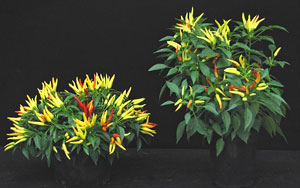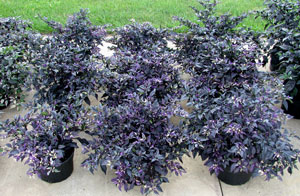2/21/2012
Offer More Than Mums
Thomas Contrisciano & Bin Liu
For many people, late August through mid-September signals a change in lifestyle. Time to put away the beach towels, take the kids to soccer practice or music lessons again, and settle back into “nesting” at home.
Over the past several years, many retailers reported increases in sales of fall home decorating items. Of course, this includes Halloween decorations, but also goes well beyond that. As part of this trend, many garden centers have noticed an increased demand for interesting, colorful plants. Hay rides, corn mazes and pumpkin-decorating contests have now become part of the fun activities for friends and families and can generate significant income for garden centers and other agri-businesses. For most of the country, this early fall or “back to school time” has some of the most ideal weather for being outside. The sunny, pleasantly warm days with low humidity and cooler nights are revitalizing.
Recognizing this trend, we gathered additional information on what customers are asking for in the autumn from commercial greenhouse growers and retailers over the past five years. We received some interesting feedback. While garden mums are still king and pansies and cabbage/kale are still holding their own, consumers are looking for other plant options with which to decorate their entryways, patios, decks, etc. Growers also are getting requests from commercial landscapers for something new to install. Interestingly, the plants didn’t have to be frost or winter hardy—they just needed to provide a lot of color and lush foliage for the four- to 10-plus weeks after purchase until frost. In addition, growers often commented that price competition on the traditional fall items, especially mums, can be cutthroat.
Introducing Mum Pals
With that information in hand, we embarked on a multi-year research program at PanAmerican Seed/Kieft-Pro-Seeds to address this increasing need in the marketplace. We explored annuals and first-year-blooming perennials (FYBP), collectively called Mum Pals, which meet the following criteria:
- Easy and relatively inexpensive (low-energy input with free heat and light due to outdoor production) for growers to produce over the summer on an existing average mum production regime along with a mum crop
- Offer a wide variety of plant habits and flower types to commercial landscapers and home gardeners
- Focus on flower/foliage/fruit colors including orange, yellow, red and purple that are popular in the autumn
- Offer reduced price competition items at the wholesale and retail levels
The trials were conducted over three years at the PanAmerican Research Facility in Elburn, Illinois. The methods varied slightly each year, but essentially were as follows:
- Wide assortment of annuals and FYBP were trialed
- Sow date in greenhouse: Mid-May for FYBP and ornamental peppers, and mid-June for other varieties
- Plug tray size: 288 cells for everything, except ornamental millet, which were 72 liners
- Transplanting plug to finished container: Varied by sow date, but generally around 4 to 5 weeks after sow
- Moved from greenhouse to outdoor production area in full sun: 2 weeks after transplanting
- Container size: 8 in. x 5 in. black mum pots for all varieties
- Number of plugs per pot (PPP): Evaluated 1 to 3
- Fertilizer program: Constant feed with 300 ppm N via drip irrigation
- No PGRs or pesticides used
- No deadheading performed

For ornamental peppers, fruiting was generally greater in outdoor production (left).
Research details
Overall results were excellent, even during the cooler than normal summer of 2010 in Elburn. The sow and transplant times listed above were on target for most varieties to finish when needed. As to be expected, warmer temperatures (to a point) resulted in faster growth.
In our trials, we started with 288-cell size plugs, but it’s acceptable to also utilize larger-sized plugs and transplant at a later date. Also in our research, plugs were transplanted into the finished container and remained in a greenhouse for about 2 weeks. However, growers can transplant into the finished container and put pots right out in the field given adequate irrigation and fertilization. Plants will root out and grow relatively quickly that time of year.
The research showed that in most cases, one plug per pot yielded suitable results, but three plugs per pot yielded the bushiest plants with the most color.
Daylength did not play a role in most varieties trialed. However, negative effects of decreasing daylength were seen on a few varieties, including coreopsis Early Sunrise. Flowering was non-uniform, whereas if these varieties were sown in late winter or early spring, flowering would be quite uniform across the crop. For that reason, we are not recommending those varieties for this production schedule for fall sales. Daylength also affected the African marigold Taishan series. Plants finished beautifully, but were taller than desired in an 8 in. x 5 in. pot and would be aesthetically best suited to a deeper container.
Of great benefit to growers and retailers, plants remained vibrant, colorful and saleable over many weeks. This helps ease the challenge of having to hit a specific date for finish and sale. This extended season of color is also a benefit to the consumer who can enjoy the plants whether planted in the ground or left in the container until frost. Many of the trialed varieties are also tolerant of drying down in the pot. This is another advantage both at retail and for the consumer.

This illustrates the advantages of using 3 plants per pot. From left to right, 1 ppp, 2 ppp, and 3 ppp.
Similar trials over the past two years were conducted by commercial growers in the Northeast, Mid-Atlantic and Midwest utilizing these outlined production techniques. Overall, most growers reported their crops finished on time as planned and sales were good. These production techniques can also be adapted for growers in the South, Southwest and West.
Research was also conducted on a few ornamental pepper varieties to determine any differences between plants grown in a greenhouse and plants grown outdoors with similar production methods. Results indicated that in some varieties, plants in the greenhouse were taller than their outdoor counterparts, while in others there was no noticeable difference. Intuitively, the higher light levels and mechanical action of wind in outdoor production generally leads to naturally more compact and bushier plants with more fruits. PGRs were not applied to the research plants, but could be in summer greenhouse production if needed. Also in the case of ornamental peppers, fruiting was generally greater in outdoor production.
Recommended Mum Pals
FYBP and Ornamental Peppers
Coreopsis Rising Sun and Sunfire
Dianthus Amazon Neon Purple
Dianthus Bouquet Purple
Dianthus Dynasty Orchid, Purple, Red
Gaillardia Mesa Bright Bicolour and Yellow
Lavender Lavance Purple
Ornamental Pepper Black Pearl*
Ornamental Pepper Calico
Ornamental Pepper Chilly Chili
Ornamental Pepper Garda Hocus Pocus
Ornamental Pepper Peppa Blanca-Rose
Ornamental Pepper Peppa Lila Naranja
Ornamental Pepper Peppa Orangina
Ornamental Pepper Peppa Pepperoni
Ornamental Pepper Peppa Purple/Tangerine
Ornamental Pepper Purple Flash
Ornamental Pepper Sangria
Other Annuals
Celosia Icecream Cherry, Orange
Helenium Dakota Gold
Hibiscus Mahogany Splendor *
Marigold Taishan Orange, Gold, Yellow*
Ornamental Millet Jade Princess, Purple Baron, Jester*
Rudbeckia Moreno
Zinnia Zahara Fire, Scarlet, Yellow, Bonfire Mix
Zinnia Double Zahara Fire
*Taller. Best in larger container.
Research summary
There is a wide variety of PanAmerican Seed/Kieft-Pro-Seeds annuals and first-year- blooming perennials with vibrant, fall-oriented colors that can be successfully grown along with mums and sold in the late summer and early autumn period (see above).
- Choosing researched and recommended varieties eliminates grower uncertainty
- Two different sow dates about 2 weeks apart works best—ornamental peppers and FYBP first, and all other varieties 2 weeks later (see above)
- 3 plants per 8 in. x 5 in. mum pot is recommended
- Production can also take place in a greenhouse using a similar regime; however, some varieties may need an application of PGRs to encourage compactness
- Recommended varieties remain saleable for the grower and retailer and showy for the consumer for many weeks until frost
These plants can easily be combined at retail and in the garden with mums, pansies, cabbage/kale and ornamental grasses for attractive displays.
Continued research and evaluation is planned on additional varieties. With sustained positive results, the palette of colorful plants for fall sales to the commercial landscape and home garden markets will continue to expand even further.
GT
Thomas Contrisciano is a product representative for the Northeast and Mid-Atlantic Regions, and Bin Liu is a cultural research specialist for PanAmerican Seed based in West Chicago, Illinois.